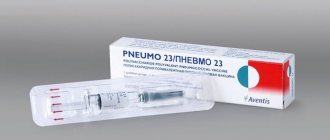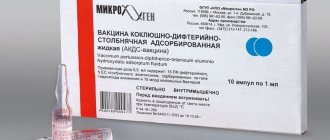| Service | Price |
| Poliorix (prevention of Poliomyelitis) | 1,200 rub. |
The drug "Poliorix" is a vaccine that promotes the effective development of immunity against the most common and most dangerous strains of polio: I, II and III.
The drug has been known for more than ten years and is actively used to vaccinate the population against a dangerous disabling disease.
The vaccine is produced in Belgium under license from the famous British medical concern GlaxoSmithKline. The suspension is supplied in ampoules containing one dose of the drug equal to 0.5 milliliters.
"Poliorix" is used to prevent the incidence of polio in adults and children. In order to prevent a dangerous disease, vaccinations can be given as early as three months of age.
Pharmacodynamics and pharmacokinetics
Pharmacodynamics
A vaccine made from of polio viruses that are inactivated by formaldehyde . Causes the production of neutralizing antibodies against all three serotypes . Antibodies are produced after the second injection, immunity to viruses appears after the 3rd injection, intensifies and persists for 5 years after revaccination . Preclinical data showed no harm to humans.
Pharmacokinetics
No data.
Who should get the polio vaccine?
The vaccine is designed for patients over three months of age and has no other age restrictions. Vaccination promotes the development of stable immunity, while refusal to vaccinate not only sharply increases the risk of illness and puts the patient at risk, but also increases the risk of infection for others.
Vaccine composition:
- Inactivated strains of polio: Type 1 - 40 medical units;
- The second type - eight medical units;
- Third type - 32 medical units;
Analogs
Level 4 ATC code matches: Imovax Polio
Imovax Polio .
Which is better Imovax Polio or Poliorix?
There are no fundamental differences between these inactivated vaccines. They are identical in composition, quality and reactogenicity. They differ only in the manufacturer: Poliorix is Belgian, Imovax Polio is French. The vaccines are completely interchangeable; in the absence of one, you can continue vaccinating with the other. IPV tolerated , first of all, because it does not contain “live” polio , is safer for children, and secondly, it contains a small amount of antigens .
Safety precautions before vaccination
To ensure that the vaccination process is safe and does not lead to complications, you should follow simple safety measures:
- To make sure that your body is completely healthy and there are no hidden infections, you can take a general blood test to control it;
- Refrain from culinary experiments and do not introduce new and unusual foods into the diet for several days after receiving the vaccine;
- Avoid visiting crowded places a couple of days before vaccination to avoid accidental infection;
- It is strictly forbidden to wet or comb the injection site.
Reviews of Poliorix
Immunoprophylaxis is the basis of the fight against infections. With its help smallpox , measles and mumps . Severe infections that cause high morbidity in childhood, including polio . Poliorix, as a vaccine option, is currently widely used.
Vaccination against polio can be carried out with OPV (oral polio vaccine with weakened live pathogens) or IPV (inactivated vaccines): Imovax Polio or the above-mentioned polio vaccine Poliorix. Regardless of the vaccine, the child will be equally protected. Antibodies against this disease begin to be produced immediately after the first vaccination, but the necessary and long-term protection is formed after at least two to three injections. In the case of vaccination with inactivated vaccines, protection after the first revaccination lasts 5 years, so the second revaccination is done after five years, and the third at 14 years. The national calendar of preventive vaccinations contains a vaccination scheme with inactivated and “live” oral vaccines, as well as a scheme for combining them. Inactivated or “acellular” vaccines are less reactogenic, especially for children with allergic diseases. Therefore, acellular vaccines are used as an alternative in these children.
The first two vaccinations for children under one year of age are given the IPV according to the timing of vaccination; it is also used in older children who have not been vaccinated against this disease before. Imovax Polio has been used in Russia since 1996, so the results of its use are well known, but Poliorix has only been used since 2009, and parents are afraid to use it and are looking for the former in every possible way.
- “... We are about to get the Poliorix vaccine, I’m very worried, but the doctor said that it’s an analogue of Imovax.”
- “...Today we are going to get this vaccination. I hope everything works out. Imovax could not be found.”
- “... We gave this vaccination to a 3.2 year old child. We prepared 5 days in advance - we drank Zyrtec . They tolerated the vaccination perfectly.”
- “... We were vaccinated with Poliorix, everything was fine, there was no reaction.”
However, complications from Poliorix are rare, and most often it is a temperature reaction.
- “... We were vaccinated with this vaccine for the 3rd time. The first two times there were no reactions, and the third time with a temperature of up to 37.5, she sleeps restlessly, but is alert and has a normal appetite.”
- “... My daughter’s temperature stayed at 39 all night, we didn’t do anything to bring it down, and it dropped by morning.”
- “... We had a high temperature for 2 days. People at the clinic were surprised, they said this happens very rarely.”
- “... We did it three times. The second time - fever for 2 days, the third time - rash, diarrhea and fever for 5 days. Although everyone convinces us that there is no reaction to this vaccine.”
The polio vaccine is recommended to be given together with the DTP (against diphtheria , whooping cough and tetanus ), since they coincide in vaccination schedules. There are vaccines available in the Russian Federation: domestic DPT and Belgian Infanrix So parents have a choice. Most often, parents choose Infanrix + Poliorix.
- “... I am very glad that they did it with these drugs. There was no reaction."
- “... We gave Fenistil before this vaccination, everything went great!”
- “... I’ve heard only positive things about these vaccines.”
- “... There was no reaction at all. Even redness at the injection site.”
Why is polio dangerous?
Poliomyelitis is a viral disease that leads to dangerous complications, affecting the nervous system and especially the spinal cord, leading to paralysis and various sluggish paresis.
Poliomyelitis can be transmitted with both mild symptoms and a full range of unpleasant phenomena. The mild form of polio is characterized by rapid fevers, catarrhal symptoms, and dyspepsia. In the severe form, symptoms typical of inflammatory processes in the brain are added: deformities of the arms and legs, autonomic disorders, peripheral paralysis, and others.
Vaccination is an effective measure of protection against polio, which is dangerous because:
- At the onset of the disease, there is an increase in body temperature, increased sweating and diarrhea;
- Skin rashes are observed throughout the body, acute muscle pain and painful sensations when urinating;
- Inflammation of the membranes of the brain and disruption of the functioning of internal organs occurs;
- Poor health is observed due to sudden changes in blood pressure, depression of respiratory function;
- The legs fail and paralysis of the lower half of the body occurs.
Since polio is spread by airborne droplets and the oral-fecal route, being close to the source of the disease makes it quite easy to become infected: just contact with a dirty object is enough.
As a result of polio, serious disability develops and the person cannot return to normal life.
Vaccination is a simple and effective measure that can protect your health.
SIDE EFFECTS
General disorders and reactions
- Anxiety;
- Irritability;
- Low-grade fever;
- Hyperemia and pain at the injection site, infiltration at the injection site;
- Malaise;
- Cry;
- Drowsiness;
- Decreased appetite;
- Rash on the skin;
- Cough.
The safety profile of the POLIMILEX vaccine in clinical trials varied among patients of different ages. The above reactions, with the exception of pain at the injection site, were typical only for infants aged 3 to 6 months.
The recorded reactions to the administration of the POLIMILEX vaccine were mild, short-lived and disappeared within 1-3 days.
In addition, due to the simultaneous administration of other vaccines with the POLIMILEX vaccine, a precise cause-and-effect relationship between the occurrence of adverse events and the use of the vaccine cannot be established.
Post-registration surveillance data. Below are the data for commercial use of the drug outside the Russian Federation.
Local and systemic reactions
- Swelling
- Redness;
- Pain at the injection site;
- Fever;
- Polyneuropathy;
- Apnea in premature infants born at ≤28 weeks of gestation.
The identified reactions to the vaccine were mild, short-lived and disappeared within 1-3 days.
CONTRAINDICATIONS
- Severe reaction to previous administration of the POLIMILEX vaccine;
- Known hypersensitivity to one or more components of the vaccine;
- A disease accompanied by fever, an acute infectious or chronic disease in the acute stage. Vaccination is carried out 2-4 weeks after recovery or during the period of convalescence or remission. For mild ARVI, acute intestinal diseases, etc., vaccinations are carried out immediately after the temperature has normalized.
- Severe reaction (temperature above 40C, swelling and hyperemia at the injection site more than 8 cm in diameter) or a complication of the previous administration of the drug.
Office photo
Useful articles
Interesting facts about medicine History of vaccination Vaccination is one of the greatest achievements of medicine, allowing to save 2 to 3 million lives annually. Preview picture in attachment Healthy lifestyle Medical examination: typical misconceptions About the importance of the correct approach to interpreting the results of a medical examination Healthy lifestyle Sleep - strong and healthy Simple rules that will help make your sleep complete.
Show more articles
Make an appointment
- More about the center
- Licenses and documents
- Our vacancies
- Contacts
- Ask a Question
- Leave feedback
- Territorial program
© 2002-2022 LLC 'Medilux-TM' - Network of medical centers | Site map All information, including prices, is provided for informational purposes and is not a public offer (Article 435 of the Civil Code of the Russian Federation, Article 437 of the Civil Code of the Russian Federation)
INN: 7725100534 OGRN: 1037700249872
Medilux-TM LLC uses cookies (files with data about past visits to the site) to personalize services and provide user convenience. You can prevent the storage of cookies in your browser settings. MedSwiss takes the protection of personal data seriously - read the terms and conditions for processing it.
Accept user agreement
POLYMILEX®
(Vaccine for the prevention of polio, inactivated)
Manufacturer: Nanolek LLC (Russia)
Composition: A suspension of purified and formalin-inactivated viruses containing three types of polio viruses: type 1 (Mahoney) 40 units of D-antigen type 2 inactivated (MEF 1) 8 units of D-antigen type 3 inactivated (Saukett) 32 D-antigen units The permanent Vero cell line developed by WHO is produced for production.
Release form: Suspension for intramuscular and subcutaneous administration. 0.5 ml in a glass bottle with a capacity of 3 ml, closed with a rubber stopper and a tamper evident aluminum cap.
Indications for use: Used for active immunization of the population in accordance with the National Preventive Vaccination Calendar for the prevention of polio.
COMPOUND
One dose (0.5 ml) contains:
Active substances
- Poliomyelitis virus type 1 - 40 units of D - antigen;
- Poliomyelitis virus type 2 - 8 units of D - antigen;
- Poliomyelitis virus type 3 - 32 units of D - antigen.
Excipients
- 2 – phenoxyethanol – 2.5 mg;
- Formaldehyde - 0.0125 mg;
- Sodium phosphate disubstituted dihydrate - 0.43 mg;
- Sodium phosphate monosubstituted monohydrate - 0.22 mg;
- Sodium chloride - 2.96 mg;
- Potassium chloride - 0.16 mg;
- Magnesium sulfate heptahydrate - 0.08 mg;
- Phenol red - 0.008 mg;
- Calcium chloride dihydrate - 0.08 mg;
- Water for injections.
ORAL POLIOMYELITIS VACCINE
(Oral live polio vaccine)
Manufacturer: Enterprise for the production of bacterial and viral preparations of the Institute of Poliomyelitis and Viral Encephalitis named after M.P. Chumakov RAMS Federal State Unitary Enterprise (Russia)
Composition: Oral polio vaccine is a preparation from attenuated Sabin strains of polio virus types 1, 2, 3, grown on a primary culture of African green monkey kidney cells or on a primary culture of African green monkey kidney cells with one passage on a continuous cell culture of the Vero line in the form solution with 0.5% lactalbumin hydrolyzate in Earle's solution.
Release form: Solution for oral administration is transparent, from yellowish-red to pinkish-crimson in color, without sediment, without visible foreign inclusions.
Indications for use: Prevention of polio in children from 3 months to 14 years. The vaccine creates lasting immunity to polio virus types 1, 2, 3 in 90-95% of those vaccinated.
Vaccination regimen: To prevent polio in Russia, a combination of 2 doses of inactivated vaccine and 3 doses of live oral vaccine is used. Live oral vaccine (OPV) is used to vaccinate children against polio in the first year of life after two injections of inactivated polio vaccine (Immovax Polio®, Poliorix®) and for the full course of vaccination in children over one year of age. Revaccination is carried out only with OPV.
The primary vaccination course consists of 3 doses of the vaccine and two booster doses. Immunization schedule: first administration, then the second after 45 days from the first, then the third after 45 days from the second. The first revaccination is a year after the completed third, the second revaccination is two months after the first. The use of the vaccine is not clearly related to age. It is important to comply with vaccination dates.
If the deadlines are extended, vaccination will not be resumed. Violation of the vaccination schedule can lead to a decrease in the intensity of immunity to the components of the vaccine.
It is allowed to reduce the interval between the third and fourth vaccinations to 3 months, if the intervals between the first three vaccinations have been significantly extended. Thus, taking into account the modern Vaccination Calendar, the third administration of the polio vaccine ends the course of vaccination, and the fourth administration is the first revaccination. A single dose is 4 drops (0.2 ml), administered orally.
Contraindications: – neurological disorders that accompanied previous vaccination with oral polio vaccine; – immunodeficiency state (primary), malignant neoplasms, immunosuppression (vaccinations are carried out no earlier than 6 months after the end of the course of therapy); – routine vaccination is postponed until the end of acute manifestations of the disease and exacerbation of chronic diseases. For mild ARVI, acute intestinal and other diseases, vaccinations are carried out immediately after the temperature normalizes.
Application experience: Vaccination with a live vaccine is necessary to create intestinal immunity. This vaccine has been used since the early 60s of the 20th century, first in the form of pills, then in the form of pink droplets. Experience with the use of this vaccine has shown its good tolerability and indicates the high immunity that is formed in a person after its use.





